including Paul Curtis of Platanna Press about to publish a totally updated edition of Fishing the Margins, an epic series of salmonid muggings when Clem Booth fishes Lake Strobel in Patagonia, Dirk Human writes charmingly about his first love – nymphing yellowfish from ‘his side’ of the Vaal, the Catskill Fly Fishing Centre and Museum hosts a South African exhibit and hail the size of golf balls in KZN
Paul Curtis of Platanna Press about to publish a totally updated edition of Fishing the Margins
Says Paul:
News on my own new book 'Fishing Wider Margins' is that it's in final proofreading stage and should go to the printers in April. It's over 500 pages long with 160 colour pages. It gives the details and history of 259 books written on African fish and fishing since Victorian times - most of which are in my own library. I've been doing research for the last five years and it's taken over a year to write. It's aimed mainly at collectors, but should be of interest to anyone who loves African fishing whether fly, rock and surf, inland or deep sea.
Click in images to enlarge them
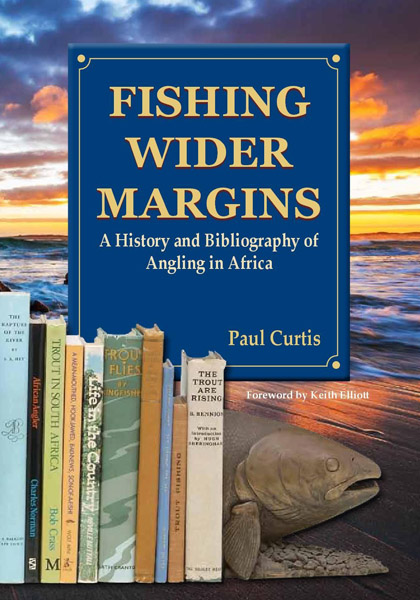
There's so much wonderful fishing writing that's come out of Africa - I have no doubt that much of it is on a par with the best done worldwide. Certainly in terms of both subject matter and the skill and passion of the fishermen and authors who've written about Africa.
The Yellow DDD scores a mention
I am pleased (and proud) to say that the Yellow DDD is included in Rick Takahashi and Jerry Hubka’s latest book Modern Terrestrials – Tying and Fishing the World’s most Effective Patterns.
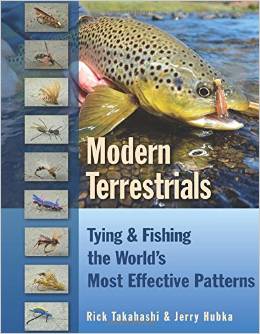
An epic series of salmonid muggings! Clem Booth on Lake Strobel
Says Clem:
After months of planning and anticipation, I set off last week with good friend Peter Cockwill (who fondly remembers you from his visit to South Africa) and a new friend Kevin Brown, for Lake Strobel in Patagonia. More specifically, we were the guests of the Luciano Albo at the incomparable Estancia Laguna Verde.
It is a long trip; London Heathrow to Buenos Aires, fly south to El Calafata and then drive five and a half hours on some very rough roads! After a bit of warm-up fishing in Laguna Verde - a very big lake right outside the lodge where we caught rainbows to 6 pounds – we headed off to Lake Strobel the next morning. It is a sight to behold; 10 miles of crystal clear, blue water. I've never seen anything like it; this part of Patagonia is pretty special and I guess this should have been apparent when a Condor tracked our vehicle while driving from El Calafata! To call it remote is an understatement; you are truly in an area which is the same as it would have been eons ago.
It blows a lot in Patagonia but we had four calm days out of six which was great and a little lucky. Huge, gloriously conditioned rainbows seemed in endless supply; although make no mistake, one has to really focus to land them as runs are deep into the backing. Keeping these leviathans out of the rocks is also no mean challenge and I have plenty of straightened hooks, broken tippets and a snapped 8 weight rod to prove it! Not to mention hands with more cuts and line burns than a rugby player may endure playing on the concrete hard fields of a Gauteng winter!

A superb chromer
They are truly beautiful fish; some silver, akin to steelhead or Atlantic salmon (‘chromers’ they call them) and others with a splash of beautiful pink down the flanks.
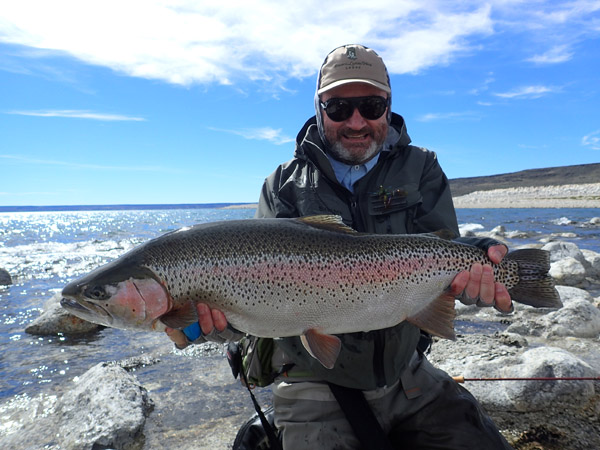
A splash of beautiful pink down the flanks
Our party had countless ‘doubles’ (fish over 10 pounds) including the season’s record of 24 pounds which fell to Kevin. What a fish that was! My personal best was 17.5 pounds which was a good deal bigger than any rainbow I've done battle with in the better part of 50 years of fly fishing.
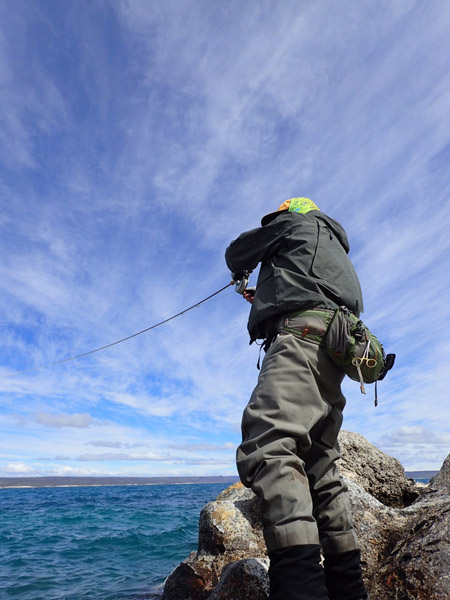
When the wind blows it blows
When the wind dies down, one turns to the dry fly and these submarines which mostly gorge themselves on scuds and daphnia start to hurl themselves at mice patterns and Chernobyl Ants with all the gay abandon of Test brownies during Duffers Fortnight. A great method is a New Zealand rig with a tiny nymph below a dry fly. Guide Nano, peering into my fly box, spied a Number 18 Zak nymph and I kid you not, this little fly which last saw action with you Tom on a Cape stream then accounted for a bunch of gargantuan fish to 15 pounds before it finally expired, exasperated I suspect by the epic series of Salmonid muggings!
One lives like a king at Estancia Laguna Verde. Luciano and his team see to one's every need and there neither is there a shortage of wonderful Argentinean wines nor delicious steaks.
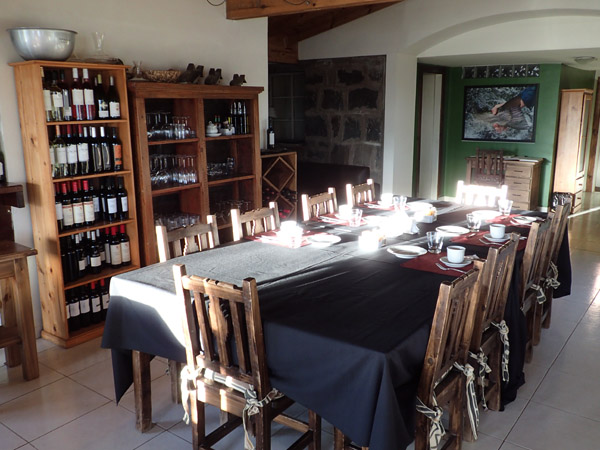
No shortage of wonderful Argentinean wines
He is himself a fly fisherman of great ability and the evenings were spent in the usual discussions where truth and fantasy merge like some of our great Cape blends. We even had a musical evening although I suspect that our renditions of the works of Jim Morrison and Neil Young may not quite have been of the quality we perceived!
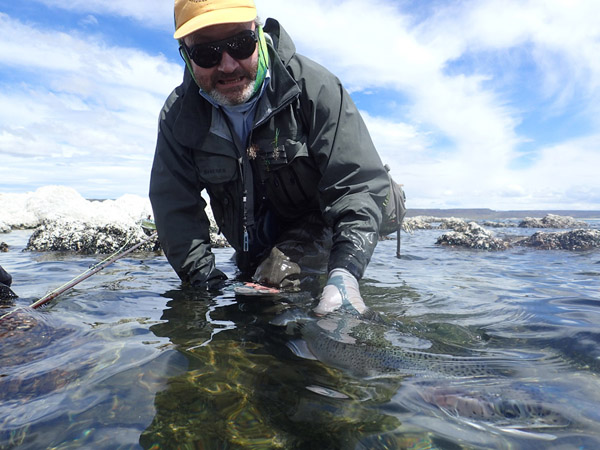
The release of a 15 pounder
I was using an 8 weight. Suspect a 9 weight will make more sense when the wind blows, which is quite frequent. I used 15 pound tippets. There are loads of rocks and the fish aren't leader-shy.
I had fish run up to 150 metres (not kidding!) and had my 8 weight broken on a fish that was 15 lb plus. Hook straightened.
Not quite like the polite trout of the Test and Itchen! I will never forget this visit to fly fishing paradise and we fully intend to show up again in 2016.
Quotes of the week
At its most intrinsic …fly-fishing is about nothing so much as a lone soul in perfect harmony with surrounding nature – a single corpuscle synchronised to the pulse of a perfect universe.
This is a quote from Bitch-Creek Nymphing & the Millennium Bug by Wolf Avni, published in 2007. Wolf lives on the edge of a marvellous lake in the high Drakensberg where he grows fish against a backdrop that in many respects is probably unparalleled for beauty in this country. He is also an accomplished photographer.
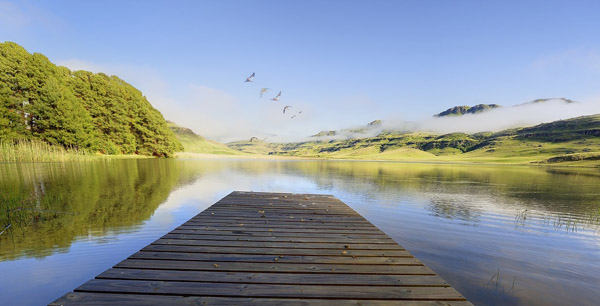
The view from Wolf’s home. (Photo by Wolf Avni)
The second quote is from the opening lines of Steven Meyer’s book San Juan River Chronicle – Personal Remembrances of one of America’s Best-Known Trout Streams. You will rarely come across a better written book on rivers and fly fishing – or a more revealing one – when it comes to the challenges and the nature of a blue ribbon river, its guides and its anglers. Here’s the quote:
My house rests on the border between two worlds – two worlds as different as ice and fire – that are connected to each other by clear running water and trout.
Dirk Human writes charmingly about his first love – nymphing yellowfish from ‘his side’ of the Vaal
I grew up alongside the Vaal. It has been the anchor of my fishing dogma ever since. Once I was a bait fisherman and loathed yellows and fished carp and Cape Sharptooth Catfish. But slowly I got interested in Artlure, but with the price of rapalas and big barbel breaking a few off and snapping a pistol grip Shimano rod and stripping a bait-caster reel, I soon realised that as a schoolboy my finances would not be afloat for long.
So I invested in cheap Shakespeare 6-weight rod and the most basic of reels, bought a few ‘prince’ flies and taught myself to cast. Those days info was hard to find. There was no internet as now and I think the idea of fishing with indicators on the Vaal was still in its experimental or ‘secret’ phase. Most locals laughed at me; called me crazy to even try it. Bait fishing was the norm then, and sadly still is on my side of the big river.
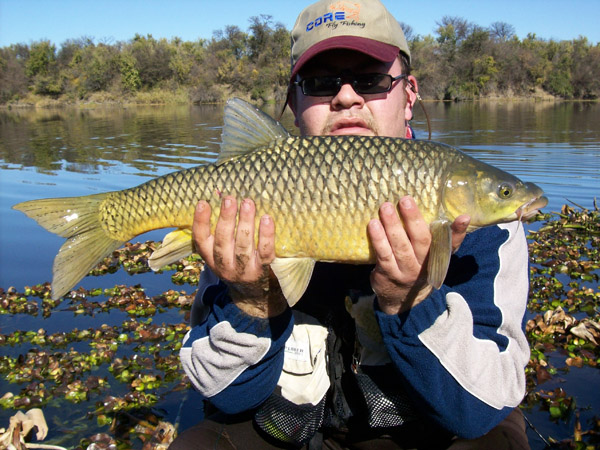
Dirk Human
So fishing was done by casting into cross- and downstream currents with a single fly, a bead head nymph and no other weight. It took me a month to get my first yellow, but the feeling of a fish on a fly rod, the take, the direct almost primitive feeling of the rod bending, and also realizing the respect a fish must get on such a rod, as force would only result in a broken tippet and a shattered ego.
In time I learned to fish indicators. In summer and during winter, I still fish single flies on slow retrieves, almost the same technique Horst Filter uses I think. The Vaal in Bothaville area is not the same as the Vredefort Dome area near Potchefstroom. It is slower, shallower and much wider with large pools and lots of sand and broken ridges of ysterklip (iron stone) that cause rapids, so it’s not suited to Czech nymphing or heavy nymphing.
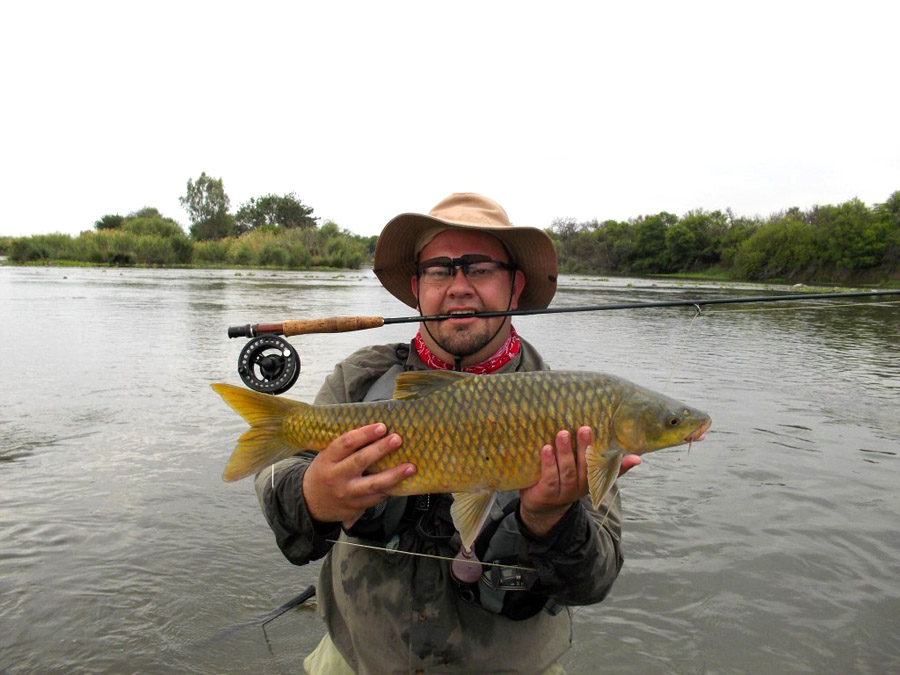
I went through the whole process. First it was about just getting the fish, then getting a lot, then I specialised in targeting only 2.5 kg-plus fish. I knew the water, got my technique perfect; the old New Zealand-style rig using medium-sized nymphs, casting 15-20 meters upstream and bringing in the line always ready for a strong strip-strike. There’ve been many burned fingers and a few dives after lost rods.
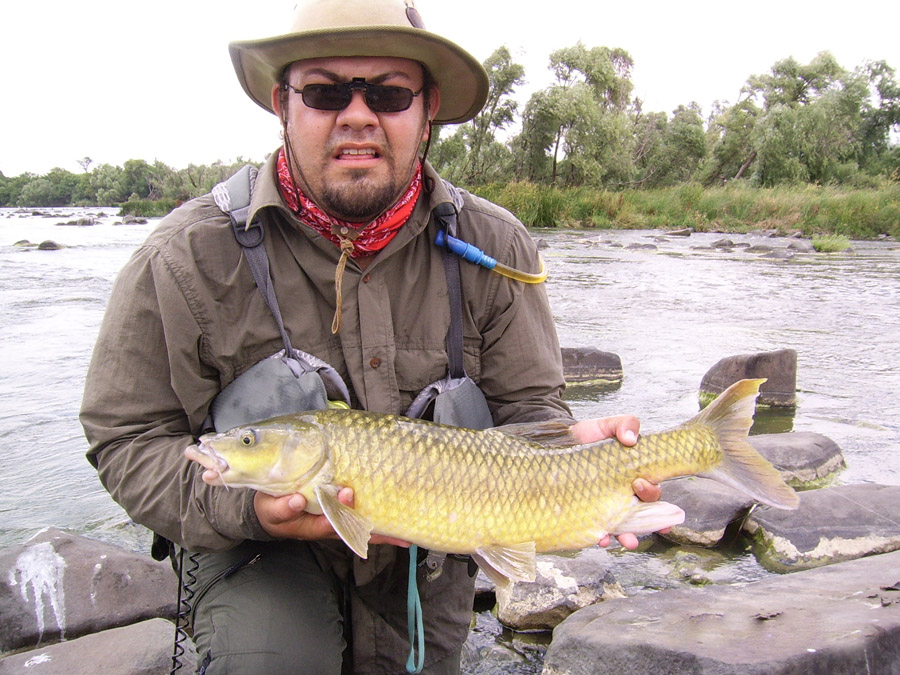
Sure the smallmouths are not as numerous as in the dome area, but they seem to get bigger this side, and for some unknown reason, don't rise as prolifically as their cousins upstream. I did fish dries with Carl Nicholson who took over from Keith Wallington, who was a mentor to me in those days, with Garth Wellman and Carl and of, course, with Gerrit Redpath, who I knew from Steynsrus school days.
These days I just go and fish. I like being in nature and on this section of river you see no one and the farmer, who is also my preacher at church, has left nature to go her own way. Lots of otters, giant Heron's and even once a lost baby hippo are among the tales I can tell about this section of river that has been my home for more than ten years.
The Catskill Fly Fishing Centre and Museum hosts a South African exhibit
Peter Brigg writes:
The SA Fly Fishing Exhibition at the home of fly fishing in America, the Catskill Fly Fishing Centre and Museum, is ready to be shipped on Monday 9 February, thanks to the generosity of KZN Tourism who kindly agreed to cover the cost of the courier service.
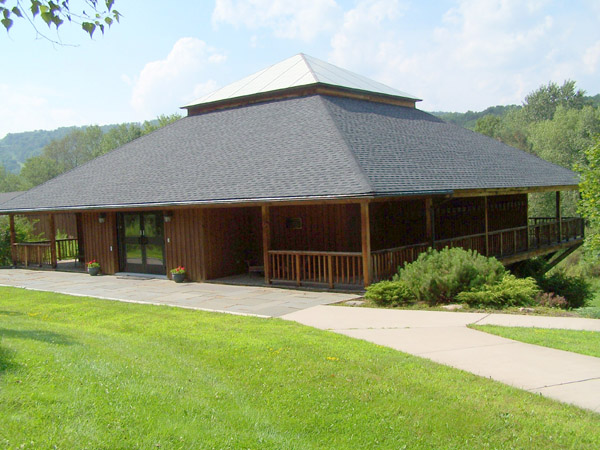
The Catskill Fly Fishing Centre and Museum in Livingston Manor New York
My thanks to all those (too many to mention individually)who took the time to submit individual profiles providing a good cross-section of what is on offer in SA, the guides, authors, artists, craftsmen, clubs and organizations, donations of books, images, magazines, maps, DVD’s, flies and more. To mention some of the significant donations I’d like to express my thanks especially to Tom Sutcliffe for copies of all his books, Ed Herbst for his Fly Tying DVD’s and a copy of the reprint of The Rapture of the River, Jay Smit for a J Vice which he delivered personally last year, FOSAF for a complete collection of their books, Flyfishing and The Complete Fly Fisher magazines for copies of their magazines and Barry Kent for a complete set of High Flies first edition stamps.
I’d like to make special mention of a few individuals that gave so generously of their time to help with specific elements of the exhibition - Tim Rolston (profiles), Gordon van der Spy (fly collection), Warren Prior (Video of fly fishing images) and Sheena Carnie, large wall map showing the major fly fishing areas in SA and the target species. Without their expertise, assistance and support, this exhibition is unlikely to have seen the light of day – thank you.
The coverage will be extensive considering the number of visitors to the Centre daily and many from around the world. I will provide further feedback once the exhibition is up and running.
(Peter has worked hard at this and he has succeeded admirably. Well done Pete! TS)
Jan Korrubel’s report from KwaZulu-Natal
A mere 16mm in my rain gauge for the week here in Nottingham Road doesn’t quite explain the topsy-turvy weather country wide. Tuesday had reports of snow from Underberg down through the Eastern Cape. Snow in February, really? Friday night saw a massive storm move down from the Midlands, nearly flooding Hilton and pelting Pietermaritzburg with hail the size of golf to cricket balls. The damage was extensive.
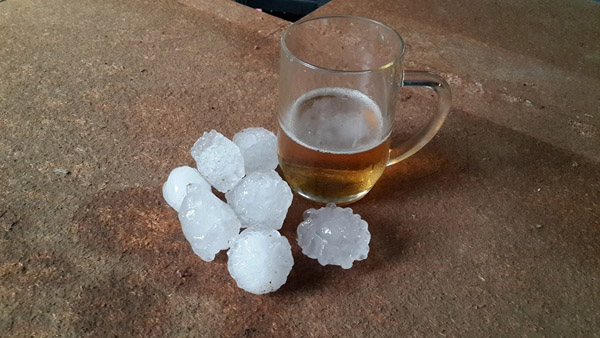
Hail stones the size of golf balls. Julian Titshall image
Roger Baert’s visit to Natal came to end this week. Wolf Kittle came up from Pietermaritzburg on Thursday, collected Roger from his lodgings outside Rosetta, and we had a farewell lunch at one of the local establishments.
Roger Baert (left), author of Meandering Streams, at his KZN farewell lunch
Roger departed for Johannesburg on Friday and will still be in the country, mainly touring Mpumalanga (eastern Transvaal), until the end of the month when he and Brigitte head back to France. Roger left me with a couple of signed copies of his book, Meandering Streams, so if anybody needs a copy, please give me a shout at This email address is being protected from spambots. You need JavaScript enabled to view it.">This email address is being protected from spambots. You need JavaScript enabled to view it..
After the rains of last week, the rivers should be near perfect, so concentrate your efforts on the rivers rather than stillwaters for the time being.



